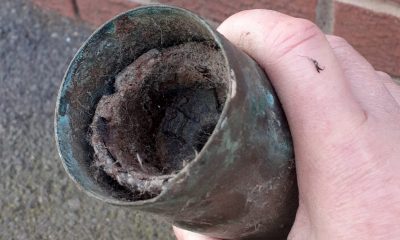Caribbean breadfruit traced back to trees introduced by UK explorer
The Caribbean is one of the largest producers of breadfruit worldwide.
Published
1 year ago onBy
Talker News
By Stephen Beech via SWNS
Caribbean breadfruit can be traced back to sapling trees introduced by Captain William Bligh 230 years ago this week - 45 months after the infamous Mutiny on the Bounty.
Plant biologists have for the first time identified five lineages of the crop in the region and connected them to the original Tahitian lineages introduced by Bligh in 1793.
Bligh led a mission to introduce seedless breadfruit from Tahiti in the South Pacific to the Caribbean as a cheap food to feed slaves on British plantations.
But his expedition failed to list what types of breadfruit they introduced.
Now the new study, published in the journal Current Biology on the 230th anniversary of Bligh’s arrival in the Caribbean, has traced five major lineages of Caribbean breadfruit back to that single introduction.
Bligh docked HMS Providence at Kingstown in St Vincent and the Grenadines on January 5, 1793, carrying a cargo of several hundred sapling breadfruit trees.
His goal was to introduce the long-lived trees with their carbohydrate-rich fruits to cheaply feed British slaves laboring on the islands’ sugar plantations.
Bligh is best remembered for the infamous Mutiny on the Bounty, subsequently made into a classic Hollywood movie starring Charles Laughton and Clark Gable that won the 1936 Best Picture Oscar. The film has been remade twice since.
Bligh and his crew aboard the Royal Navy cutter HMS Bounty stopped at Tahiti where they worked with locals to collect breadfruit.

But the plans were abruptly abandoned in April 1789 when some of the Bounty’s crew seized control of the ship, casting Bligh and 18 loyal crew members off in a small boat.
Despite the mutineers thinking it was a death sentence, Bligh and his men managed to reach Timor alive after a journey of 3,618 nautical miles in the 23-foot (seven meters) launch.
He remained dedicated to the original goal of collecting and transporting breadfruit.
Just two years later, he set sail again — this time on HMS Providence with an accompanying vessel, HMS Assistant.
Although Bligh recorded the names of eight types of breadfruit in his log for the Bounty, the Providence’s logs are curiously missing the crucial details.

Study senior author Professor Nyree Zerega, of Northwestern University’s Weinberg College of Arts and Sciences in the U.S., said: “When you look at the logs from the Bounty, Bligh carefully documented what was collected.
“But on his second voyage, the time spent in Tahiti was shorter, and there weren’t any notes about the names of the breadfruit cultivars they actually collected.
"He did indicate that five kinds of seedless breadfruit were collected, but subsequent historical texts have suggested different numbers.
"Wanting to know this is partly curiosity, but it’s also useful because it links cross-cultural knowledge about the plants.
“Breadfruit is an under-utilized crop, and it doesn’t get nearly as much attention as the major crops.
“However, interest in breadfruit is increasing globally, and we thought this would be a fascinating puzzle to solve.”
Study first author Lauren Audi said: “Outside of Oceania, the Caribbean is one of the largest producers of breadfruit worldwide.
“And we really don’t know much about the genetic diversity of the fruit in the Caribbean.
Because this is an important crop for food security - especially for island nations that are highly susceptible to climate change - we wanted to characterize the genetic diversity of breadfruit crops in order to conserve them.
"The first step for that is to characterize the diversity of what we already have.”
The research team integrated local knowledge with historical documents and specimens, observations about the fruits’ size, shape and texture and targeted genome sequencing.
They traveled throughout St Vincent, collecting leaves and taking measurements, such as leaf size, fruit size and shape.
The team supplemented the samples with historical dried, pressed specimens stored in museums and botanic gardens around the world — including a specimen collected in 1769 from the HMS Endeavour Voyage led by Captain James Cook.
Back in the lab, the research team analyzed more than 200 individual breadfruit specimens, focusing predominantly on seedless breadfruit from St Vincent and Tahiti as well as samples from around the world.
The process involved extracting and sequencing DNA from leaf samples. Among the samples, the researchers ultimately identified eight major global breadfruit lineages - five of which are found in the Caribbean and likely represent the original 1793 introduction by the HMS Providence.
Study co-author Doctor Diane Ragone, of the Breadfruit Institute at the National Tropical Botanical Garden, Hawaii, said: "This is an exciting project.
“Through laboratory, herbarium and library research and fieldwork in Tahiti and the Caribbean and by studying breadfruit trees conserved at the National Tropical Botanical Garden in Hawaii, three generations of women scientists were able to provide answers to a centuries-old mystery: 'Which varieties of breadfruit did Captain Bligh introduce into the Caribbean?’”
Audi, who was a graduate student in Prof Zerega’s lab but is now a Ph.D. candidate at New York University, said: “We identified five genetic lineages in the Caribbean, which matches what we found in some historical texts.
“It was exciting to tease apart this history and characterize breadfruit’s diversity in the Caribbean genomically for the first time.”
Prof Zerega added: “Still, there may be more types of breadfruit in St Vincent than our genetic methods could identify because they are so closely related.
“Even if we don’t find genetic differences among plants that people assign different names to, those names still have significance and value.”
Breadfruit has become an important part of the Caribbean diet and culture. It is starchy and seedless, playing a culinary role more like a potato. The nutrient-rich food is high in fiber, vitamins and minerals.
Bligh, who in 1806 was appointed Governor of New South Wales in Australia, died aged 63 in 1817 having reached the rank of Vice-Admiral.
Stories and infographics by ‘Talker Research’ are available to download & ready to use. Stories and videos by ‘Talker News’ are managed by SWNS. To license content for editorial or commercial use and to see the full scope of SWNS content, please email [email protected] or submit an inquiry via our contact form.
You may like


New breakthrough treatment boosts cancer-fighting cells


Signs of multiple sclerosis can show up in blood years before symptoms


Why baby sharks prefer swimming in shallow water


Scientist transforms climate change data into classical music


Breakthrough may help unlock way to prevent diabetes


Having this type of job could reduce risk of memory issues
Other Stories


New breakthrough treatment boosts cancer-fighting cells
The approach involves activating the immune cells in the body and "reprogramming" them to attack and destroy the cancer cells.


One-year-old can’t stop laughing during first ride at Disneyland
"We didn't expect him to love it that much."


Dad running marathon wearing chainmail weighing over 40 pounds
A dad is attempting to break the world record for the fastest marathon while wearing chainmail.


Hero saves elderly couple by dragging them out of burning car
The Good Samaritan jumped into action after spotting the fire on his way to work.


Bomb squad seals off town after ammunition shell donated to charity shop
Staff discovered the device in a bag of donations.
Top Talkers

 Parenting1 day ago
Parenting1 day agoSingle mom details struggles of feeding her 12 kids

 Broadcast4 days ago
Broadcast4 days agoOver 40% of Americans have no clue what a 401k is

 Broadcast3 days ago
Broadcast3 days agoHow hard is it for Americans to live sustainably?

 Broadcast1 week ago
Broadcast1 week agoGrocery shopping hungry is costing Americans this much

 Funny1 week ago
Funny1 week agoCops confused by crow mimicking police siren

 Shopping1 week ago
Shopping1 week agoGrocery shopping hungry costs Americans this much every trip

 Money3 days ago
Money3 days agoOver 40% of Americans have no clue what a 401k is

 Parenting1 week ago
Parenting1 week agoIt takes this many minutes for the average American kid to get bored
